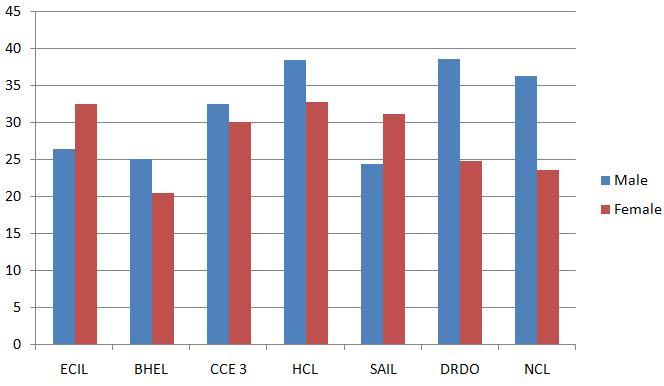The Odisha High Court Assistant Section Officer (ASO) examination is highly competitive, and mastering quantitative aptitude is essential for success. Here, we present the top 30 multiple-choice questions (MCQs) that will help you prepare effectively for the exam.
Top 30 Quantitative Aptitude MCQs For Odisha High Court ASO
Q(1 – 5). Study the following bar chart carefully and answer the questions given below.
The graph below shows the number of male and female employees (in lakhs) in each of seven organizations: ECIL, BHEL, CCE, HCL, SAIL, DRDO, and NCL, which are part of various government offices in India. Each subsidiary’s total workforce is the sum of its male and female employees. Together, the total workforce of these seven subsidiaries constitutes one-fourth of the country’s population.

1. For how many subsidiaries is the percentage of population of that subsidiary less than 14.5% of the one by fourth part of the country’s population?
(a) Zero
(b) One
(c) Three
(d) Four
2. For how many subsidiaries is the ratio of the number of females to the number of males less than that for the one by fourth part of the country?
(a) 1
(b) 2
(c) 3
(d) 4
3. If, in each subsidiary, exactly 60% of the males and 40% of the females are literate, which subsidiary has the third highest illiterate population?
(a) ECIL
(b) DRDO
(c) HCL
(d) CCEE
4. If it is given that that there are no widows or widowers in the seven subsidiary then, For how many subsidiary is it possible that the population of the unmarried persons in the subsidiary is less than 10% of the population of the subsidiary?
(a) One
(b) Two
(c) Three
(d) Four
Solution: (d)
(a) ECIL, DRDO and BHEL
(b) BHEL only
(c) HCL and SAIL
(d) ECIL, BHEL and SAIL
- If x+y=21 and xy=110, find the value of x2+y2.
a) 221
b) 241
c) 331
d) 321
Answer: a
Explanation: We know that, (x + y)2 = x2 + y2 + 2xy.
212 = x2 + y2 + 2*110.
x2 + y2 = 221. - If a-b=16 and a2-b2=544, find the value of 2ab.
a) 350
b) 450
c) 500
d) 550
Answer: b
Explanation: a – b = 16 …… (i)
a2-b2 = (a+b) * (a-b) = 544.
a + b = 34 …… (ii)
On solving (i) and (ii), we get,
a = 25 and b = 9.
Therefore, 2ab = 2*25*9 = 450. - Find the value of p, if pq = 24 and p2 + q2 = 52.
a) 8 or 3
b) 12 or 2
c) 6 or 4
d) 1 or 24
Answer: c
Explanation: pq = 24 …… (i)
(p + q)2 = p2 + q2 +2pq
(p + q)2 = 52 + 48 = 100.
p + q = 10 …… (ii)
On solving (i) and (ii), we get,
p2 – 10p + 24 = 0.
p = 6 or 4. - If X + Y = 174, and X is half of Y, then find the value of X.
a) 58
b) 116
c) 57
d) 114
Answer: b
Explanation: X + Y = 174 …… (i)
Y = 2X …… (ii)
On solving (i) and (ii), we get,
X = 58. - If a, b, c, ……, x, y, z are 26 natural numbers, then what is the value of (t-a)(t-b)(t-c)……(t-y)(t-z)?
a) 26
b) 13
c) 1
d) 0
Answer: d
Explanation: t is also a natural number among 26 natural numbers of a, b, c, ……, x, y, z.
(t-t) is an element in (t-a)(t-b)(t-c)……(t-y)(t-z).
(t-t) = 0. Hence, (t-a)(t-b)(t-c)……(t-y)(t-z) = 0. - A : b :: c : d = 2 : 3 :: 4 : 6. If A = 125, find b + c – d.
a)250
b) 62.5
c) 31.35
d) 125
Answer: b
Explanation:
Let the proportion be in terms of x.
A = 2x, b = 3x, c = 4x, and d = 6x
Given: 2x = 125
Therefore, x = 125 / 2 = 62.5
b = 3x = 62.5 * 3 = 187.5
c = 4x = 62.5 * 4 = 250
d = 6x = 62.5 * 6 = 375
b + c – d = 187.5 + 250 – 375 = 62.5 - 4 numbers a, b, c, and d are in proportion. If b = 87 and c = 91, which of the following cannot be a value of d?
a) 2639
b) 2638
c) 29
d) 3
Answer: b
Explanation:
a * d = b * c
87 * 91 = a * d
a * d = 7917
d should be a divisor of 7917 to fit in the proportion.
From the options, 2638 cannot be a value of d. - A sum of money is distributed among a, b, c, and d in the proportion 3 : 4 :: 6 : 5. If b gets 1260 rupees less than c, find the share of a.
a) 1890 rupees
b) 1980 rupees
c) 1800 rupees
d) 1900 rupees
Answer: a
Explanation:
Let the shares be in terms of x.
A’s share = 3x, b’s share = 4x, c’s share = 6x, and d’s share = 5x
The difference between c’s share and b’s share = 1260 rupees
6x – 4x = 1260
2x = 1260 rupees
x = 1260 / 2 = 630 rupees
A’s share = 3x = 630 * 3 = 1890 rupees - The ratio of the ages of 3 people is 3 : 7 : 9. If the sum of their ages is 190 years, find the difference between the ages of the eldest and the youngest.
a) 50 years
b) 60 years
c) 30 years
d) 45 years
Answer: b
Explanation:
Let the ages of the people be in terms of x.
3x + 7x + 9x = 19x = 190 years
x = 190 / 19 = 10 years
The difference between the eldest and the youngest person = 9x – 3x = 6x = 60 years - The ages of 3 people are in the ratio 7 : 11 : 12. If the sum of their ages is 45, find the difference between the ages of the eldest and the youngest in months.
a) 90 months
b) 96 months
c) 102 months
d) 108 months
Answer: a
Explanation:
Let their ages be in terms of x.
The total of their ages = 7x + 11x + 12x = 30x
30x = 45
x = 45 / 30 = 1.5 years
The difference between the age of the eldest and the youngest = 12x – 7x = 5x
5x = 5 * 1.5 = 7.5 years = 7.5 * 12 months = 90 months - 20 men can do a piece of work in 50 days. Find the amount of work done by 70 men in 5 days.
a) 25%
b) 35%
c) 45%
d) 55%
Answer: b
Explanation:
The total work to be done = 20 men * 50 days = 1000 units
The amount of work done by 70 men in 5 days = 70 men * 5 days = 350 units
The percentage of work done = (350 / 1000) * 100 = 35% - 54 men can do a work in 12 days. Find the amount of work done by 5 men in 12 days.
a) 9%
b) 10%
c) 11%
d) 12%
Answer: a
Explanation:
The total work done by 54 men in 12 days = 54 men * 12 days = 648 units
The work done by 5 men in 12 days = 5 men * 12 days = 60 units
The percentage of the work done = (60 / 648) * 100 = 9.25% - 43 men can do a work in 89 days. Find the amount of work done by 90 men in 55 days.
a) 129%
b) 130%
c) 131%
d) 132%
Answer: a
Explanation:
The total work to be done = 43 men * 89 days = 3827 units
The work done by 90 men in 55 days = 90 men * 55 days = 4950 units
The percentage of work done = (4950 / 3827) * 100 = 129.34% - 64 men can do a piece of work in 90 days. Find the amount of work done by 95 men in 50 days.
a) 82%
b) 83%
c) 84%
d) 85%
Answer: a
Explanation:
The total work to be done = 64 men * 90 days = 5760 units
The amount of work done by 95 men in 50 days = 95 men * 50 days = 4750 units
The percentage of work done = (4750 / 5760) * 100 = 82.46% - 65 men can do a piece of work in 87 days. Find the amount of work done by 9 men in 125 days.
a) 19%
b) 20%
c) 21%
d) 22%
Answer: b
Explanation:
The total amount of work to be done = 65 men * 87 days = 5655 units
The amount of work done by 9 men in 125 days = 9 men * 125 days = 1125 units
The percentage of work done = (1125 / 5655) * 100 = 19.89% - A train 250 m in length crossed a station 500 m in length in 45 seconds. Find the time needed by the train to cover 50 km.
a) 0.75 hours
b) 0.83 hours
c) 1 hour
d) 1.12 hours
Answer: b
Explanation:
The speed of the train = distance / time = (250 m + 500 m) / 45 s = 750 m / 45 s = 16.66 m/s.
The speed in km/h = 16.66 * 3.6 = 60 km/h.
The time taken to cover 50 km = 50 km / 60 km/h = 0.83 hours. - A train 350 m long crossed a station of equal length in 105 seconds. Find the time required by the train to cover 1270 km.
a) 52.91 hours
b) 52.92 hours
c) 52.93 hours
d) 52.94 hours
Answer: b
Explanation:
The speed of the train = distance / time = (350 m + 350 m) / 105 s = 700 m / 105 s = 6.66 m/s.
The speed in km/h = 6.66 * 3.6 = 24 km/h.
Time taken to cover 1270 km = 1270 km / 24 km/h = 52.92 hours. - The speed of a train is 45 km/h. Find the time required by the train to cross a station of 500 m if the train is 340 m long.
a) 1.02 hours
b) 1.12 hours
c) 1.20 hours
d) 1.21 hours
Answer: b
Explanation:
The speed of the train = 45 km/h = 12.5 m/s.
The time required = (500 m + 340 m) / 12.5 m/s = 840 m / 12.5 m/s = 67.2 seconds = 67.2 / 60 = 1.12 hours. - A train is x meters long. The train crosses a station 5x meters long in 40 seconds. Find the speed of the train in terms of x.
a) 25x / 47 km/h
b) 27x / 50 km/h
c) 30x / 53 km/h
d) 33x / 56 km/h
Answer: b
Explanation:
The speed of the train = distance covered / time taken = (5x + x) / 40 s = 6x / 40 s = 0.15x m/s.
The speed in km/h = 0.15x * 18 / 5 = 27x / 50 km/h. - A train with a speed of 12.5 km/h crosses a station 125 m long in 125 seconds. Find the length of the train.
a) 209 m
b) 259 m
c) 309 m
d) 359 m
Answer: c
Explanation:
The total distance covered = speed * time.
Speed of the train = 12.5 km/h = 12.5 * 1000 / 3600 m/s = 3.472 m/s.
The distance = 3.472 m/s * 125 s = 434 m.
The length of the train = 434 m – 125 m = 309 m. - A piece of wire 40cm long is bent into the form of an arc subtending an angle of 120 degree at the centre. What will be the radius (in cm) of the circle so formed?
a) 60 / π
b) 20 / π
c) 120 / π
d) 30 / π
Answer: a
Explanation: According to the question,
Length of arc = 40 cm
Angle in degree = 120
➩ Length of arc = (Angle in degree / 360) * 2πr
➩ 40 = (120 / 360) * 2πr
➩ r = (40 * 360) / (120 * 2π)
➩ r = 60 / π cm - What will be the area of a sector (in sq. cm.) of a circle with radius 42 cm and sector angle 240 degrees?
a) 3350
b) 4623
c) 3696
d) 5128
Answer: c
Explanation: Area of sector = (angle in degree / 360) * πr2
➩ Area of sector = (240 / 360) * (22 / 7) * 42 * 42
➩ Area of sector = 3696 cm2 - What will be the area of the circle (in sq. cm.) that can be inscribed in a square of side 20cm?
a) 150π
b) 75π
c) 200π
d) 100π
Answer: d
Explanation: According to the question, the radius of the circle would be half of the side of the square.
➩ r = 20 / 2 = 10 cm
Area of circle = πr2
➩ Area of circle = π * 10 * 10
= 100π cm2 - What will be the radius of the circle (in cm) for which the circumference and the area are numerically equal?
a) 2
b) 4
c) π
d) 2π
Answer: a
Explanation: Let the radius of the circle be r cm.
➩ πr2 = 2πr
➩ r2 = 2r
➩ r = 2 cm - If the radius of a circle is increased by 500%, then by what % does it’s area increases?
a) 3200%
b) 4000%
c) 3500%
d) 3800%
Answer: c
Explanation: Area of circle with radius r = πr2.
New radius = r + 500% of r = r + 5r = 6r.
New area = π (6r)2 = 36πr2
Increased area = 36πr2 – πr2 = 35πr2
% increase in area = ((35πr2) / (πr2)) * 100
= 3500%










